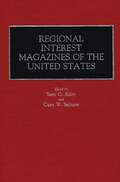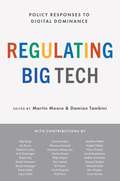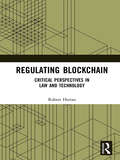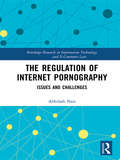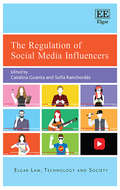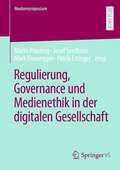- Table View
- List View
Regional Interest Magazines of the United States (Historical Guides to the World's Periodicals and Newspapers)
by Sam Riley Gary W. SelnowIn Regional Interest Magazines of the United States, Sam G. Riley and Gary W. Selnow focus on those magazines that direct their attention to a particular city or region and reach a fairly general readership intersted in entertainment and information. This work is a follow-up to their earlier Index to City and Regional Magazines of the United States. Titles are arranged alphabetically to facilitate access; each entry includes a historical essay on the magazine's founding, development, editorial policies, and content. Entries also include two sections that provide data on information sources and publication history, arranged in tabular form for ready reference.In choosing the magazines to be profiled, Riley and Selnow attempted to represent not only the biggest and most successful of this genre, but also some smaller and newer titles, plus significant earlier magazines that are no longer in print. Special care was also taken to achieve an even geographical spread. To attain greater accuracy, regional writers were enlisted to do the entries on their own region. These writers provide valuable information on how the various magazines began, how conditions have caused them to change, their problems, their editors and publishers, and their content as well as colorful and little known facts of their operation. Magazines were arranged alphabetically, and two informative appendices list the profiled titles by founding date and geographic location. This volume will be a valuable resource for students of magazine publishing history.
Regional Parallelism and Corruption Scandals in Nigeria: Intranational Approaches to African Media Systems
by Muhammad Jameel Yusha'uRegional Parallelism and Corruption Scandals in Nigeria is a ground-breaking book that offers fresh perspectives on the character and role of the African media in covering corruption scandals. It explores whether reports regarding corruption stem from the efforts of journalists who employ investigative journalism, or if it is a mere coincidence promoted by the activities of anti-corruption agencies. To that end, the book develops a media systems theory for Africa based on the coverage of corruption scandals in the Nigerian press. This new theoretical paradigm, defined as regional parallelism, argues that African countries are nations within nations, and that therefore any comparative study of the media system should recognize this understanding. The book combines both interviews with journalists as well as qualitative content analysis of newspapers to determine the patterns and issues that influence the reporting of corruption. It also looks at corruption within the media itself, taking into account factors such as regionalism and ethnicity within the practice of journalism.
Regionalentwicklung im Spannungsfeld von Nachhaltigkeit und Identität
by Marko IvanisinDer Autor entwickelt ein Regionenmodell, das jenseits physischer und struktureller Grenzen und Rahmungen auf der Ebene der kommunikativen Vernetzungen aufbaut. Bei dem neuen Regionenbegriff geht es nicht mehr um geographisch, wirtschaftlich und/oder politisch abgegrenzte und sich selbst genügende Agglomerate, sondern um interessenbasierte Netzwerke, die sich vermittels partizipatorischer Kommunikation auf der Ebene der sozialen Konstruktion als sozial organisierte Modelle darstellen.
Regionaler Pressemarkt und Publizistische Vielfalt: Strukturen und Inhalte der Regionalpresse in Deutschland und Österreich 1995–2015
by Ramona Vonbun-Feldbauer Johanna Grüblbauer Simon Berghofer Jan Krone Klaus Beck Dennis Steffan Leyla DogruelDer Band untersucht den langfristigen Einfluss pressepolitischer Maßnahmen und ihrer Konsequenzen auf die strukturelle und die inhaltliche Vielfalt in regionalen Pressemärkten und führt Erkenntnisse aus der Pressekonzentrationsforschung, der Vielfalts- und Qualitätsforschung sowie der kommunikationspolitischen Presseforschung zusammen. Anhand einer Strukturanalyse der regionalen Pressemärkte in Deutschland und Österreich werden stabile und dynamische regionale Zeitungsmärkte identifiziert. Stabilität und Dynamik beziehen sich dabei auf Eigentumsverhältnisse und die Anzahl von Titeln/publizistischen Einheiten. Für jedes Land werden die Presseerzeugnisse jeweils einer dynamischen und einer stabilen Region einer Inhaltsanalyse unterzogen. Durch das Längsschnittdesign mit drei Messzeitpunkten sind, neben Vergleichen zwischen den Ländern sowie zwischen dynamischen und stabilen Pressemärkten, inhaltliche und formale Veränderungen der Vielfalt regionaler Presse fassbar. Zudem wird die interne journalistische Vielfalt einer bestimmten Zeitung in Bezug auf ihre (wechselnde) Marktposition verglichen.
Regionalism and the Reading Class
by Wendy GriswoldGlobalization and the Internet are smothering cultural regionalism, that sense of place that flourished in simpler times. These two villains are also prime suspects in the death of reading. Or so alarming reports about our homogenous and dumbed-down culture would have it, but as Regionalism and the Reading Class shows, neither of these claims stands up under scrutiny—quite the contrary. Wendy Griswold draws on cases from Italy, Norway, and the United States to show that fans of books form their own reading class, with a distinctive demographic profile separate from the general public. This reading class is modest in size but intense in its literary practices. Paradoxically these educated and mobile elites work hard to put down local roots by, among other strategies, exploring regional writing. Ultimately, due to the technological, economic, and political advantages they wield, cosmopolitan readers are able to celebrate, perpetuate, and reinvigorate local culture. Griswold’s study will appeal to students of cultural sociology and the history of the book—and her findings will be welcome news to anyone worried about the future of reading or the eclipse of place.
Regionalism and the Reading Class
by Wendy GriswoldGlobalization and the Internet are smothering cultural regionalism, that sense of place that flourished in simpler times. These two villains are also prime suspects in the death of reading. Or so alarming reports about our homogenous and dumbed-down culture would have it, but as Regionalism and the Reading Class shows, neither of these claims stands up under scrutiny—quite the contrary. Wendy Griswold draws on cases from Italy, Norway, and the United States to show that fans of books form their own reading class, with a distinctive demographic profile separate from the general public. This reading class is modest in size but intense in its literary practices. Paradoxically these educated and mobile elites work hard to put down local roots by, among other strategies, exploring regional writing. Ultimately, due to the technological, economic, and political advantages they wield, cosmopolitan readers are able to celebrate, perpetuate, and reinvigorate local culture. Griswold’s study will appeal to students of cultural sociology and the history of the book—and her findings will be welcome news to anyone worried about the future of reading or the eclipse of place.
Regionalnachrichten im Hörfunk: Verständlich schreiben für Radiohörer
by Karl-Albrecht ImmelWie gestalte ich Nachrichten – strukturell, inhaltlich, sprachlich? Was macht einen guten Leadsatz aus? Die Reihe klassischer Fehler in vielen Meldungen ist schier endlos: Die wichtigste Botschaft wird irgendwo im Text versteckt. Gedankensprünge und überfrachtete Meldungen verwirren Hörer und Leser. Dazu kommen bürokratische Substantivierungen, doppelte Verneinung und unnötige Passivkonstruktionen, haarscharf daneben liegende Metaphern, unübersichtliche Zahlensalate, falsche Präpositionen und erklärungsbedürftige Fachbegriffe. Besonders beliebt: der falsche Gebrauch von Indikativ und Konjunktiv in der indirekten Rede. Anhand vieler Beispiele werden die wichtigsten Regeln systematisch erläutert und oft vorkommende Fehler analysiert – ein kompaktes Buch für Nachrichtenredakteure und Pressesprecher, aber auch für alle, die sich klar ausdrücken wollen.
The Regularized Fast Hartley Transform: Optimal Formulation of Real-Data Fast Fourier Transform for Silicon-Based Implementation in Resource-Constrained Environments (Signals and Communication Technology)
by Keith JonesMost real-world spectrum analysis problems involve the computation of the real-data discrete Fourier transform (DFT), a unitary transform that maps elements N of the linear space of real-valued N-tuples, R , to elements of its complex-valued N counterpart, C , and when carried out in hardware it is conventionally achieved via a real-from-complex strategy using a complex-data version of the fast Fourier transform (FFT), the generic name given to the class of fast algorithms used for the ef?cient computation of the DFT. Such algorithms are typically derived by explo- ing the property of symmetry, whether it exists just in the transform kernel or, in certain circumstances, in the input data and/or output data as well. In order to make effective use of a complex-data FFT, however, via the chosen real-from-complex N strategy, the input data to the DFT must ?rst be converted from elements of R to N elements of C . The reason for choosing the computational domain of real-data problems such N N as this to be C , rather than R , is due in part to the fact that computing equ- ment manufacturers have invested so heavily in producing digital signal processing (DSP) devices built around the design of the complex-data fast multiplier and accumulator (MAC), an arithmetic unit ideally suited to the implementation of the complex-data radix-2 butter?y, the computational unit used by the familiar class of recursive radix-2 FFT algorithms.
The Regularized Fast Hartley Transform: Low-Complexity Parallel Computation of the FHT in One and Multiple Dimensions
by Keith John JonesThis book describes how a key signal/image processing algorithm – that of the fast Hartley transform (FHT) or, via a simple conversion routine between their outputs, of the real‑data version of the ubiquitous fast Fourier transform (FFT) – might best be formulated to facilitate computationally-efficient solutions. The author discusses this for both 1-D (such as required, for example, for the spectrum analysis of audio signals) and m‑D (such as required, for example, for the compression of noisy 2-D images or the watermarking of 3-D video signals) cases, but requiring few computing resources (i.e. low arithmetic/memory/power requirements, etc.). This is particularly relevant for those application areas, such as mobile communications, where the available silicon resources (as well as the battery-life) are expected to be limited. The aim of this monograph, where silicon‑based computing technology and a resource‑constrained environment is assumed and the data is real-valued in nature, has thus been to seek solutions that best match the actual problem needing to be solved.
Regulating Big Tech: Policy Responses to Digital Dominance
by Martin Moore and Damian TambiniSelected chapters from this book are published open access and free to read or download from Oxford Scholarship Online, https://oxford.universitypressscholarship.com/. Since Digital Dominance was published in 2018, a global consensus has emerged that technology platforms should be regulated. Governments from the United States to Australia have sought to reduce the power of these platforms and curtail the dominance of a few, yet regulatory responses remain fragmented, with some focused solely on competition while others seek to address issues around harm, privacy, and freedom of expression. Regulating Big Tech condenses the vibrant tech policy debate into a toolkit for the policy maker, legal expert, and academic seeking to address one of the key issues facing democracies today: platform dominance and its impact on society. Contributors explore elements of the toolkit through comprehensive coverage of existing and future policy on data, antitrust, competition, freedom of expression, jurisdiction, fake news, elections, liability, and accountability, while also identifying potential policy impacts on global communication, user rights, public welfare, and economic activity. With original chapters from leading academics and policy experts, Regulating Big Tech sets out a policy framework that can address interlocking challenges of contemporary tech regulation and offer actionable solutions for our technological future.
Regulating Big Tech: Policy Responses to Digital Dominance
by Martin Moore Damian TambiniSelected chapters from this book are published open access and free to read or download from Oxford Scholarship Online, https://oxford.universitypressscholarship.com/. Since Digital Dominance was published in 2018, a global consensus has emerged that technology platforms should be regulated. Governments from the United States to Australia have sought to reduce the power of these platforms and curtail the dominance of a few, yet regulatory responses remain fragmented, with some focused solely on competition while others seek to address issues around harm, privacy, and freedom of expression. Regulating Big Tech condenses the vibrant tech policy debate into a toolkit for the policy maker, legal expert, and academic seeking to address one of the key issues facing democracies today: platform dominance and its impact on society. Contributors explore elements of the toolkit through comprehensive coverage of existing and future policy on data, antitrust, competition, freedom of expression, jurisdiction, fake news, elections, liability, and accountability, while also identifying potential policy impacts on global communication, user rights, public welfare, and economic activity. With original chapters from leading academics and policy experts, Regulating Big Tech sets out a policy framework that can address interlocking challenges of contemporary tech regulation and offer actionable solutions for our technological future.
Regulating Blockchain: Critical Perspectives in Law and Technology
by Robert HerianAs the distributed architecture underpinning the initial Bitcoin anarcho-capitalist, libertarian project, 'blockchain' entered wider public imagination and vocabulary only very recently. Yet in a short space of time it has become more mainstream and synonymous with a spectacular variety of commercial and civic 'problem'/'solution' concepts and ideals. From commodity provenance, to electoral fraud prevention, to a wholesale decentralisation of power and the banishing of the exploitative practices of 'middlemen', blockchain stakeholders are nothing short of evangelical in their belief that it is a force for good. For these reasons and more the technology has captured the attention of entrepreneurs, venture capitalists, global corporations and governments the world over. Blockchain may indeed offer a unique technical opportunity to change cultures of transparency and trust within cyberspace, and as ‘revolutionary’ and ‘disruptive’ has the potential to shift global socioeconomic and political conventions. But as a yet largely unregulated, solutionist-driven phenomenon, blockchain exists squarely within the boundaries of capitalist logic and reason, fast becoming central to the business models of many sources of financial and political power the technology was specifically designed to undo, and increasingly allied to neoliberal strategies with scant regard for collective, political or democratic accountability in the public interest. Regulating Blockchain casts a critical eye over the technology, its ‘ecosystem’ of stakeholders, and offers a challenge to the prevailing discourse proclaiming it to be the great techno-social enabler of our times.
Regulating Blockchain: Critical Perspectives in Law and Technology
by Robert HerianAs the distributed architecture underpinning the initial Bitcoin anarcho-capitalist, libertarian project, 'blockchain' entered wider public imagination and vocabulary only very recently. Yet in a short space of time it has become more mainstream and synonymous with a spectacular variety of commercial and civic 'problem'/'solution' concepts and ideals. From commodity provenance, to electoral fraud prevention, to a wholesale decentralisation of power and the banishing of the exploitative practices of 'middlemen', blockchain stakeholders are nothing short of evangelical in their belief that it is a force for good. For these reasons and more the technology has captured the attention of entrepreneurs, venture capitalists, global corporations and governments the world over. Blockchain may indeed offer a unique technical opportunity to change cultures of transparency and trust within cyberspace, and as ‘revolutionary’ and ‘disruptive’ has the potential to shift global socioeconomic and political conventions. But as a yet largely unregulated, solutionist-driven phenomenon, blockchain exists squarely within the boundaries of capitalist logic and reason, fast becoming central to the business models of many sources of financial and political power the technology was specifically designed to undo, and increasingly allied to neoliberal strategies with scant regard for collective, political or democratic accountability in the public interest. Regulating Blockchain casts a critical eye over the technology, its ‘ecosystem’ of stakeholders, and offers a challenge to the prevailing discourse proclaiming it to be the great techno-social enabler of our times.
Regulating Hate Speech Created by Generative AI
by Jay LiebowitzRegulating Hate Speech Created by Generative AI explores the new hybrid space of Human Machine Interaction (HMI) in which hate speech is represented and computed through algorithms and AI generative systems. The book is exploratory because there are still many problem-solving challenges to be faced. It is also innovative because it is not assuming that solutions lie only in technological advancements but on a broader scale. In this sense, large language models can and are being considered from a holistic view (i.e., from the different dimensions and layers of regulatory and legal governance). Highlights of the book include: Generative AI and social engines of hate An introduction to generative Artificial Intelligence application, trends, and ethics The mechanics and validation of generative AI outcomes An evaluation of Generative AI for hate speech detection Best practices and key considerations for AI regulation Using GenAI capabilities for early detection of threats in the digital environment. This book is a hard look at ways to regulate generative AI to reduce online hate and secure justice in a digital environment. Featuring research and offering practical guidelines, the book examines guidelines for regulating generative AI models, so they do not contribute to online hate disinformation and imagery.
Regulating Hate Speech Created by Generative AI
by Jay LiebowitzRegulating Hate Speech Created by Generative AI explores the new hybrid space of Human Machine Interaction (HMI) in which hate speech is represented and computed through algorithms and AI generative systems. The book is exploratory because there are still many problem-solving challenges to be faced. It is also innovative because it is not assuming that solutions lie only in technological advancements but on a broader scale. In this sense, large language models can and are being considered from a holistic view (i.e., from the different dimensions and layers of regulatory and legal governance). Highlights of the book include: Generative AI and social engines of hate An introduction to generative Artificial Intelligence application, trends, and ethics The mechanics and validation of generative AI outcomes An evaluation of Generative AI for hate speech detection Best practices and key considerations for AI regulation Using GenAI capabilities for early detection of threats in the digital environment. This book is a hard look at ways to regulate generative AI to reduce online hate and secure justice in a digital environment. Featuring research and offering practical guidelines, the book examines guidelines for regulating generative AI models, so they do not contribute to online hate disinformation and imagery.
Regulating Social Network Sites: Data Protection, Copyright and Power (Elgar Law, Technology and Society series)
by Asma VranakiDrawing on rich, empirical case studies this innovative book provides a contemporary and comprehensive exploration of the plural, dynamic and precarious processes, materials, practices, interventions and relationships on social network sites, and their resultant power effects, when copyright and data privacy rights are at stake.In pursuit of this objective, chapters develop a cutting-edge conceptual power lens that brings together Actor-Network theory and Foucauldian scholarship on power. Applying this analytical framework to the case studies of Facebook (data protection) and YouTube (copyright), Asma Vranaki draws critical attention to underexplored and novel matters in digital regulation. These matters include resistance; the materiality of regulation; complex, contingent, fragile and dynamic digital ‘regulatory spaces’; the contingency of power; law as a heterogenous ‘assemblage’; the unintended consequence of local orderings; and the links between power and spaces. Ultimately, the author demonstrates that power effects are highly localised, precarious and contingent outcomes of manifold, complex and fluid alliances between diverse humans and non-humans.Advancing various contentions on how social network sites can be successfully regulated, the empirical analyses and multi-disciplinary approaches in this book will prove invaluable to students, scholars and practitioners of law, particularly those interested in regulation, data protection and copyright in social network sites.
Regulating the Press
by Tom O'Malley Clive SoleyA free press is the cornerstone of democracy. Does this then give the press the right to print inaccurate material with relative impunity? Should the public have a statutory right of reply to inaccuracy in the press? And how free is the press in a world of converging technologies and crossmedia ownership? *BR**BR*Clive Soley and Tom O’Malley set the issues of press regulation in their historical context, focusing on the period after 1945. They specifically look at the history and record of the Press Council and assess the performance of the Press Complaints Commission. The book analyses the arguments surrounding attempts to improve standards by introducing statutory rights for the public, and the reasons for the failure of these initiatives. *BR**BR*Focusing on issues of principle such as accuracy, misrepresentation and privacy, the authors re-examine the ways in which debates over press freedom versus regulation illuminate the fundamental conflicts between a fully accountable press and the economic imperatives of the free market economy.*BR*
Regulation, Governance and Convergence in the Media
by Peter Humphreys Seamus SimpsonWith digital technologies blurring media boundaries, this book provides a detailed analysis of how the Internet is producing a convergence of the press, audio-visual and online media. Based on extensive empirical analysis, the authors analyse over 25 years of changes to media forms and expose the reality behind the notion that media convergence is inevitable and inexorable. Peter Humphreys and Seamus Simpson break new ground through exploring a diverse range of topics at the heart of the media convergence governance debate, such as next generation networks, spectrum, copyright and media subsidies. They highlight how reluctance to accommodate non-market based policy solutions creates conflicts and problems resulting in only shallow media convergence thus far. Highly accessible, this book is a valuable read for undergraduate and masters students researching digital media and communications. With guidance on a series of policy directions and innovations that should be developed to fulfil the promise of media convergence, it is also a vital tool for media and communication practitioners and policy makers.
The Regulation of Cyberspace: Control in the Online Environment
by Andrew MurrayExamining the development and design of regulatory structures in the online environment, The Regulation of Cyberspace considers current practices and suggests a regulatory model that acknowledges its complexity and how it can be used by regulators to provide a more comprehensive regulatory structure for cyberspace. Drawing on the work of cyber-regulatory theorists, such as Yochai Benkler, Andrew Shapiro and Lawrence Lessig, Murray explores and analyzes how all forms of control, including design and market controls, as well as traditional command and control regulation, are applied within the complex and flexible environment of cyberspace. It includes chapters on: the role of the cyberlawyer environmental design and control online communities cyber laws and cyber law-making. This book is an essential read for anyone interested in law and information technology.
The Regulation of Cyberspace: Control in the Online Environment
by Andrew MurrayExamining the development and design of regulatory structures in the online environment, The Regulation of Cyberspace considers current practices and suggests a regulatory model that acknowledges its complexity and how it can be used by regulators to provide a more comprehensive regulatory structure for cyberspace. Drawing on the work of cyber-regulatory theorists, such as Yochai Benkler, Andrew Shapiro and Lawrence Lessig, Murray explores and analyzes how all forms of control, including design and market controls, as well as traditional command and control regulation, are applied within the complex and flexible environment of cyberspace. It includes chapters on: the role of the cyberlawyer environmental design and control online communities cyber laws and cyber law-making. This book is an essential read for anyone interested in law and information technology.
The Regulation of Internet Pornography: Issues and Challenges (Routledge Research in Information Technology and E-Commerce Law)
by Abhilash NairThe regulation of pornography has always been a contentious issue, which has sparked wide-ranging debates surrounding the acceptability and place of pornography in society. The use of the internet to distribute and access pornography has magnified this debate and has presented a number of challenges for the law in terms of effective and proportionate regulation. Following unsuccessful attempts by states to transpose traditional laws to cyberspace, a new and radical regulatory framework eventually evolved for regulating internet pornography. In this process, the focus of the law has changed from merely controlling the publication and distribution of obscene material to a model that aims to deter private consumption of illegal content. In addition, various self- and co-regulatory initiatives have been introduced with the involvement of non-state actors, imposing a certain degree of de facto liability on intermediaries, all of which raise interesting issues. This book examines the relevant regulatory responses to internet pornography, with particular reference to the UK, but also drawing comparisons with other countries where relevant. It argues that the internet has fundamentally, and in many ways irreversibly, changed the regulation of pornography. Classifying internet pornography into three broad categories – child pornography, extreme pornography, and adult pornography – the book provides an in-depth analysis of the legal issues involved in regulating internet pornography, and argues that the notions of obscenity and indecency on their own will not provide an adequate basis for regulating online pornography. The book identifies the legitimising factors that will lend credibility and normative force to the law in order to successfully regulate pornography in cyberspace. It is the only comprehensive text that rigorously addresses the regulation of internet pornography as a whole, and offers valuable insights that will appeal to academics, students, policy makers, and those working in the areas of broader internet governance and online child protection.
The Regulation of Internet Pornography: Issues and Challenges (Routledge Research in Information Technology and E-Commerce Law)
by Abhilash NairThe regulation of pornography has always been a contentious issue, which has sparked wide-ranging debates surrounding the acceptability and place of pornography in society. The use of the internet to distribute and access pornography has magnified this debate and has presented a number of challenges for the law in terms of effective and proportionate regulation. Following unsuccessful attempts by states to transpose traditional laws to cyberspace, a new and radical regulatory framework eventually evolved for regulating internet pornography. In this process, the focus of the law has changed from merely controlling the publication and distribution of obscene material to a model that aims to deter private consumption of illegal content. In addition, various self- and co-regulatory initiatives have been introduced with the involvement of non-state actors, imposing a certain degree of de facto liability on intermediaries, all of which raise interesting issues. This book examines the relevant regulatory responses to internet pornography, with particular reference to the UK, but also drawing comparisons with other countries where relevant. It argues that the internet has fundamentally, and in many ways irreversibly, changed the regulation of pornography. Classifying internet pornography into three broad categories – child pornography, extreme pornography, and adult pornography – the book provides an in-depth analysis of the legal issues involved in regulating internet pornography, and argues that the notions of obscenity and indecency on their own will not provide an adequate basis for regulating online pornography. The book identifies the legitimising factors that will lend credibility and normative force to the law in order to successfully regulate pornography in cyberspace. It is the only comprehensive text that rigorously addresses the regulation of internet pornography as a whole, and offers valuable insights that will appeal to academics, students, policy makers, and those working in the areas of broader internet governance and online child protection.
The Regulation of Social Media Influencers (Elgar Law, Technology and Society series)
by Catalina Goanta Sofia RanchordásIn today’s society, the power of someone’s reputation, or influence, has been turned into a job: that of being a social media influencer. This role comes with promises, such as aspirational work, but is rife with challenges, given the controversy that often surrounds influencers. This is the first book on the regulation of social media influencers, that brings together legal, economic and ethical angles to further unveil the implications of influencer marketing. Thus far, influencers have been under scrutiny for not disclosing paid advertising, yet their activity has many more questionable implications. This edited volume combines insights from law, economics, ethics and communication science to reveal these implications and propose new ways in which public bodies, social media companies and citizens ought to relate to influencer marketing. Academics and students of law, economics, ethics and communication science will find policy making insights in this collection. In addition, The Regulation of Social Media Influencers will be essential reading for regulators.
Regulierung, Governance und Medienethik in der digitalen Gesellschaft (Mediensymposium)
by Marlis Prinzing Josef Seethaler Mark Eisenegger Patrik EttingerUnsere stark von netzbasierten und global verflochtenen Machtstrukturen geprägten Gesellschaften offenbaren angesichts globaler Herausforderungen und Krisen (u.a. menschengemachter Klimawandel; Corona-Pandemie; Big Data und Überwachung) ungelöste Fragen zu Ethik und Regulierung der öffentlichen Kommunikation, zu deren Klärung die Kommunikations- und Medienwissenschaft einiges beitragen kann. Die Pandemie beispielsweise ist unter anderem eine kommunikative Herausforderung, an der sich die prägende Bedeutung eines ethischen Kompasses für die Orientierung und Qualität von Journalismus erweist. Für demokratische Gesellschaften bleibt der öffentliche Diskurs zwar konstitutiv, aber zugleich gewinnt die Fähigkeit, mit Dissonanz und Streit umzugehen, immer mehr an Bedeutung. Die Beiträge des Bands befassen sich mit Theoriebildung und Normsetzung, Regulierungs- und Governancestrukturen, Regulierungsinhalten und Regulierungsherausforderungen, sowie mit Überlegungen zu einer Neujustierung der Kommunikations- und Medienethik.
Rehumanize Your Business: How Personal Videos Accelerate Sales and Improve Customer Experience
by Ethan Beute Stephen PacinelliAccelerate sales and improve customer experience Every day, most working professionals entrust their most important messages to a form of communication that doesn't build trust, provide differentiation, or communicate clearly enough. It's easy to point to the sheer volume of emails, text messages, voicemails, and even social messaging as the problem that reduces our reply rates and diminishes our effectiveness. But the faceless nature of that communication is also to blame. Rehumanize Your Business explains how to dramatically improve relationships and results with your customers, prospects, employees, and recruits by adding personal videos to emails, text messages, and social messages. It explains the what, why, and how behind this new movement toward simple, authentic videos—and when to replace some of your plain, typed-out communication with webcam and smartphone recordings. • Restore face-to-face communication for clarity and connection • Add a personal, human touch to your emails and other messages • Meet people who’ve sent thousands of videos • Learn to implement your own video habit in an easy, time-saving way • Boost your replies, appointments, conversion, referrals, and results dramatically If you’re ready to influence, teach, sell, or serve in a more personal way, Rehumanize Your Business is your guide.
